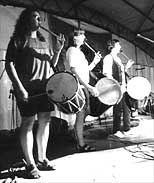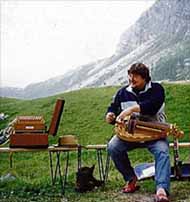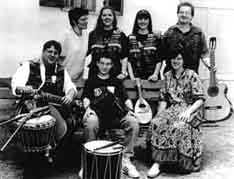Optimistic Occitanians
Young band 'Gai Saber' about their heritage - Win Gai Saber CDs


Occitania is a today fairly unknown European Region consisting of parts of Italy, France and Spain. The music traditions of Occitania are very strong and have been important for the European cultural history, drawing on the heritage of the Troubadors, poets and musicians from the beginning of this millennium. Several young musicians are blowing now new life into their musical heritage. With the support of linguistic experts, the band Gai Saber is giving those old traditions a new and fresh approach that will carry the music into the future.
 The region of Occitania is a transnational country in the Mediterranean with common roots, ancestors, culture and language. It consists of the Aran Valley in Spain, 32 departments in Southern France and 12 Valleys of the Cuneo and Turin Provinces in Italy. With a size of about 190.000 kmq, it has 13 million inhabitants, of which at least a half speak d'Oc (Occitanic) language.
The region of Occitania is a transnational country in the Mediterranean with common roots, ancestors, culture and language. It consists of the Aran Valley in Spain, 32 departments in Southern France and 12 Valleys of the Cuneo and Turin Provinces in Italy. With a size of about 190.000 kmq, it has 13 million inhabitants, of which at least a half speak d'Oc (Occitanic) language.
"This language is in fact the real amalgam of the 'occitana' population”, explains Elena of Gai Saber. "It had a great importance for the renaissance of poetry and music after the dark years of the first millennium. The Occitanic Troubadours, poets and musicians worked between the end of the XI and the end of the XIII century, and their lyrics are the most ancient lyric expression in vernacular language which is known.”
The origin of the Occitanic folk is a mix of Celtic-liguri, Iberian and Gallic with strong Latin component and Gothic contribution. Occitania has always proved that it has its own distinctive culture compared to its neighbouring folks, from the Troubadours over Mistral, the novelist in d'Oc language and Nobel Prize Winner for Literature, to the popular traditions which have survived until this day.
After the cultural revival of the sixties and the linguistic disaster of the following years which occurred with a dangerous cultural sectarianism, currently there is a new vitality in Occitanic culture, above all among young people who discover the values of this culture. The new generation does not worry about the different, new way of writing the language, but enjoys the various forms of culture and tradition that brings the cultural roots back into an every day situation, going beyond small folkloristic circles.
 Seven young musicians have started the band Gai Saber to present the old Troubadour traditions in a new way. As they say about their music, "Occitanic dance music is revisited through the performance of traditional pieces and the composition of new songs which correspond to the rhythmical schemas of the different kinds of dances. Occitanic music and Troubadour's songs are re-arranged with diverse new influences, from rhythmical and harmonical aspects of contemporary music to traditional sonorities.”
Seven young musicians have started the band Gai Saber to present the old Troubadour traditions in a new way. As they say about their music, "Occitanic dance music is revisited through the performance of traditional pieces and the composition of new songs which correspond to the rhythmical schemas of the different kinds of dances. Occitanic music and Troubadour's songs are re-arranged with diverse new influences, from rhythmical and harmonical aspects of contemporary music to traditional sonorities.”
The band uses a wide range of both traditional Occitanic and modern instruments. Traditional Occitanic instruments are ghironda (a barrel organ hurdy gurdy), lou semitoun (the diatonic accordion, introduced to their valleys only in the last century), galoubet (a little flute with three holes played with the left hand) which is played traditionally together with the lou tambourin ( a cylindrical drum), then fifre (a transverse flute with six or seven holes) and finally the piva the Occitanic bagpipes, having a very long tradition in the Occitanic valleys. And of course Gai Saber also features the oldest of all instruments, the voice. These traditional instruments meet in Gai Saber today's world, in form of guitar and keyboards, with use of sampling sound and sequencers.
Gai Saber try to mix modern sounds with the use of traditional instruments. Do they want to bring the old traditions into a modern context to attract a bigger attention? - "We think that when a culture must be defended, it begins its decadence and its death. Therefore it must be able to reinvent itself day by day in particular towards young people who are our present and our future.”
 Gai Saber research their roots by digging in a past that appears in the memory of the old people or in some documents that had been forgotten in lofts. With those digged out roots, they want to go into the contemporary lives. In their music, the old pieces are rearranged in a modern way so that also people who are not into folk music can enjoy it. At the same time, the modern sound is absolutely natural for the band as the majority of Gai Sabers musicians are very young; five of them are between 16 and 23 years old.
Gai Saber research their roots by digging in a past that appears in the memory of the old people or in some documents that had been forgotten in lofts. With those digged out roots, they want to go into the contemporary lives. In their music, the old pieces are rearranged in a modern way so that also people who are not into folk music can enjoy it. At the same time, the modern sound is absolutely natural for the band as the majority of Gai Sabers musicians are very young; five of them are between 16 and 23 years old.
The language is the centre of Gai Saber's researches, and they are getting support from scientists. "We have always worked with linguistic experts to stay as true as possible to our culture, since we deal with the poetry of the medieval troubadour poets.”
Their research about the roots of the Occitanic language and poetry has found a big interest among young people. "We carried out a course for approaching to the Occitanic medieval music in the schools, and we have just finished to work with a class of ten year old children who were well impressed, and in the end we could play some troubadour songs together. With the collaboration with the schools of Peveragno, young students can take part actively in the research about usage and customs of the language.” Recently a dictionary about the dialect of Peveragno has been edited (this can be found in Gai Saber's CD booklets, but is also used for theatre plays in co-operation with the cultural association Compagnia del Biroùn).
 They are also trying to bring the medieval music into pubs. "But this work needs the control of the linguistic experts to propose a correct form. At this moment there is the necessity to find a common language, since the Italian Occitanic area is made up of valleys with different dialects. It is necessary to find a form of standardisation to allow the use of the language in the public and teaching it in schools.”
They are also trying to bring the medieval music into pubs. "But this work needs the control of the linguistic experts to propose a correct form. At this moment there is the necessity to find a common language, since the Italian Occitanic area is made up of valleys with different dialects. It is necessary to find a form of standardisation to allow the use of the language in the public and teaching it in schools.”
Gai Saber are giving particularly attention to the phonetic differences, as their linguistic research has a cultural dimension that involves the daily life and the socio-economic situation. "Standardisation of the Catalan language (a language similar to the Occitanic) has been made in 1913, we are working on it today. An academic work must be done with a particular attention to the social world.”
During the last decades, there were lots of revival attempts from political movements that should had helped this small linguistic ethnic group, but the results have been nevertheless ineffective for many reasons. Both the French Government (Francois Fontan, one of the first experts of the Occitanic language in the Italian valleys and founder of the Autonomous Occitanic Movement, lived in exile) and the Italian Government have never done anything for their ethnic and linguistic minorities - on the contrary they have suppressed those who did not conform to an inexorable centrality.
 In France things have improved slightly. "A best bureaucracy has allowed the organisation of a structure that helps different cultural, but also socio-economic realities.” In Italy the situation is more difficult. "Although all political forces know about the necessity to reach a federal State which could give more attention to the situation of each region, there is no law yet that defends or even recognises the existence of ethnic or linguistic minorities. Recently a Parliamentarian group has prepared a law, but it is still insufficient and it will need a long time to come into force.”
In France things have improved slightly. "A best bureaucracy has allowed the organisation of a structure that helps different cultural, but also socio-economic realities.” In Italy the situation is more difficult. "Although all political forces know about the necessity to reach a federal State which could give more attention to the situation of each region, there is no law yet that defends or even recognises the existence of ethnic or linguistic minorities. Recently a Parliamentarian group has prepared a law, but it is still insufficient and it will need a long time to come into force.”
Meanwhile, the European Union shows greater interest in the demands of cultural minorities. With the aim of a Europe of the Region, it offers new possibilities for the Occitanic cultural movement.
Still, thanks to some artists, during the last years the Occitanic culture has found a greater interest even outside of the small linguistic area of Occitania. Both in the musical and the cinematographic and publishing field, there is a new interest in Occitanic culture. This revival improves also the socio-economic situation, as for example it increases the tourism.
The Occitan music has recently received lots of attention in the Italian folk world. "Some groups - like ours - are trying to reach with their different approach even a market outside of the traditional music scene. This is in Italy particularly hard because big distribution channels are not sensitive to new music directions that can be risky from the commercial point of view.”
Abroad Gai Saber has gained already bigger attention. For their new CD (Esprit de Frontiera) they hope to find foreign distributors to allow them to move beyond the Italian folk world "which is a bit narrow”, and also beyond the Italian commercialisation "which is too bound to the historical melodic song”.
 Line-Up:
Line-Up:
Maurizio Giraudo: ghironda (barrel organ - hurdy gurdy) flutes, bagpipe, semitoun or diatonic organ
Paolo Brizio: semitoun and mandolin
Maurizia Giordanengo: semitoun
Elena Giordanengo: "galoubet and tambourin" and celtic harp
Giulia Ferrero: "galoubet and tambourin" and celtic harp
Teresa Ferrero: "galoubet and tambourin"
Alessandro Rapa: bodhran, guitar, acoustic and electronic keyboards
Chiara Bosonetto: voice
CDs: 'TROUBAR R'OC' (1997) and 'Esprit de Frontiera' (1999)
Both albums will be reviewed in our next issue
Further infos/contact: Gai Saber's homepage e-mail Gai Saber.
WIN Esprit de Frontiera CD!
To take part in the competition, tell us where is Occitania.
Answers until 15/9/99 to FolkWorld.
Photo Credit: All photos from Gai Saber's Archives
Back to the content of FolkWorld Articles & live reviews
To the content of FolkWorld online magazine Nr. 10
All material published in FolkWorld is © The Author via FolkWorld. Storage for private use is allowed and welcome. Reviews and extracts of up to 200 words may be freely quoted and reproduced, if source and author are acknowledged. For any other reproduction please ask the Editors for permission.
